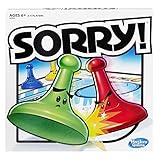

Components
- Gameboard
- 12 SORRY! pawns
- 45 cards
- Instructions
Object of the Game
Be the first player to get all three of your pawns from your start area to your home

Setup
Each player takes three pawns of one color and places them on their matching color start area. Shuffle the cards and place them face down in the center of the board.
The youngest player goes first. Play passes to the left.

Game Play
On your turn:
-
Draw a card from the SORRY! deck and follow the instructions on the card.
-
Place the card face up on DISCARD HERE.
-
If you run out of cards to draw, reshuffle the discard pile and place them face down in the center of the board.
Starting a Pawn
Any forward-moving card can move a pawn out of its start area.
Moving Around the Board
Pawns move clockwise around the board, unless a card instructs them otherwise.

Jumping and Bumping
You may jump over your own or another player's pawn if it is in your way, counting it as one space.
But, if you land on a space that's already occupied by an opponent's pawn, bump that pawn back to its own color start area and take the space!
Occupied Spaces
Only one of your pawns may occupy a space at a time, except for the start area or home.
If your only possible move would require you to land on a space already occupied by one of your other pawns, you forfeit your turn.
If at any time you cannot move, you forfeit your turn. But if you can move, you must move, even if it is not to your advantage!
Rules of the Board

-
Slide
Any time you land by exact count on the triangle at the beginning of a slide that shows your color, slide ahead to the end and bump any pawns in your way − including your own! − back to their own start areas.
If you land on a slide that does not show your color, don't slide, just stay put on the triangle.
-
Safety Zone
Only you may enter your own color safety zone. All other rules apply. No pawn may enter its safety zone by a backward move. However, a pawn may move backward out of its safety zone.
-
Safety Zone Entry Space
When moving along the outside track, you may not move your pawn forward past your own safety zone entry. However, you may pass the entry space on a backward move (4 or 10 card).
-
Home
You must bring all three of your pawns into home by exact count. Once home, do not move that pawn again for the rest of the game.
The Cards
-

Move one of your pawns forward one space.
-

Move one of your pawns forward two spaces.
-

Move one of your pawns forward three spaces.
-

Move one of your pawns backward four spaces.
-

Move one of your pawns forward five spaces.
-

Move one of your pawns forward seven spaces or split the forward move between two of your pawns.
If you use part of the seven to get a pawn home, you must be able to use the balance of the move for another pawn.
-

Move one of your pawns forward eight spaces.
-

Move one of your pawns forward ten spaces or move one of your pawns backward one space.
-

Move one of your pawns forward 11 spaces or switch any one of your pawns with an opponent's.
You may forfeit your move if you do not wish to change places and it is impossible to go forward 11 spaces.
You may only switch pawns in play on the open track, not at start, home, orin a safety zone.
If your switch landed you on a triangle at the beginning of a slide that shows your color, slide to the end.
-

Move one of your pawns forward 12 spaces.
-

Move a pawn from your start area to take the place of another player's pawn, which must return to its own start area. Or move one of your pawns forward four spaces.
If there is no pawn on your start or no opponent's pawn is on any space you can move to and you cannot move any of your pawns four spaces, you forfeit your turn.
End of the Game
Get all three of your pawns home first to win!
Click here for the vintage rules of Sorry.
Continue Reading


